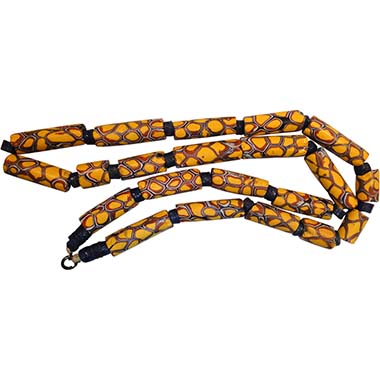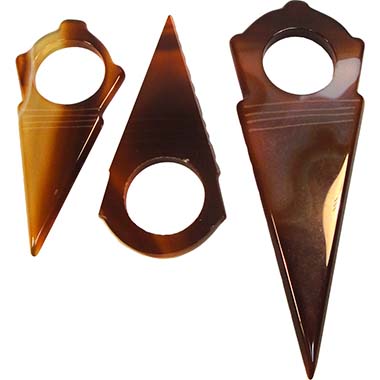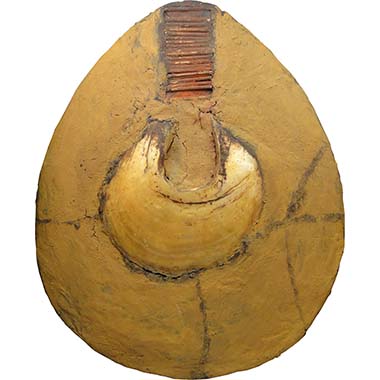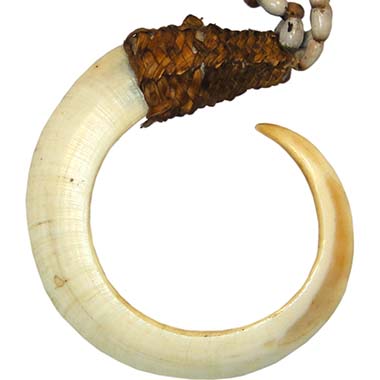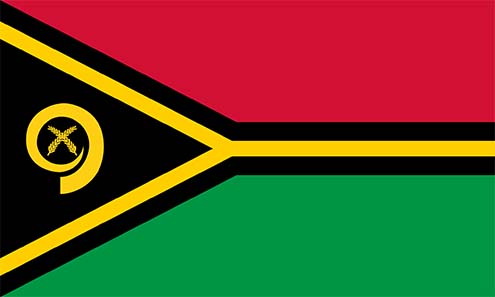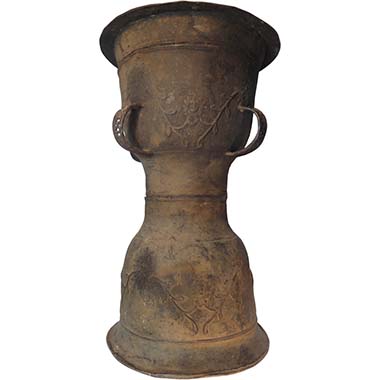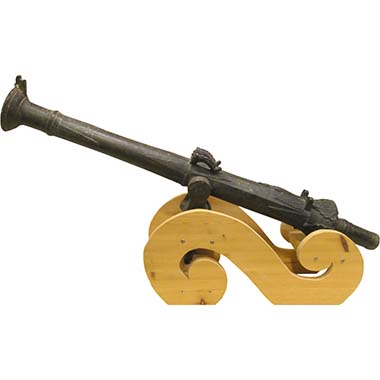by courtesy of the MoneyMuseum and the Sunflower Foundation
In 2010 the MoneyMuseum in Zurich was able to acquire a part of the Kuhn collection. At the moment, all objects are exhibited. In order to facilitate the visitors’ approach to these odd means of payment a brochure has been issued, which we publish here by courtesy of the MoneyMuseum and the Sunflower Foundation.
Jewellery as Money – Decorative Money
“Manilla,” what this Portuguese word actually meant is something that we are still not agreed upon, but the form of the manillas suggests that the ingots were originally bracelets made of bronze. When they originated it was their function to be ornamental, and in fact many forms of traditional means of payment go back to objects that were used as jewellery.
East and central Africa, Venetian glass beads. From the Kuhn Collection. Photo: MoneyMuseum Zurich.
East and central Africa, Venetian glass beads
When Henry Morton Stanley was preparing his expedition into central Africa in 1871 he was faced with the problem of which glass beads he should buy on the coast to have suitable beads for payments in the interior of the country. In 1857 the explorer Richard Francis Burton had the same problem: he describes how he had to choose from about 400 different kinds of beads.
In the 19th century in central Africa beads served as a kind of small change which was mainly used to buy foodstuffs, to pay the porters and as part of the tribute to the relevant tribal chief. However, every foreign explorer was faced with the virtually insoluble question as to which beads were accepted as a means of payment and which were not.
The 19th century travellers explained this phenomenon – completely in the style of the fashion whims of Western ladies – as the consequences of a constantly changing taste. Present-day explorers see that differently.
In the 19th century in central Africa a sophisticated system of payment is said to have arisen through the influence of Western and Indian traders. The demand for East African ivory had increased considerably and the slave trade had become far more significant. The local traders had learnt not to be satisfied with worthless civilisation goods. They had very precise ideas of what they wanted to exchange. European traders, on the other hand, who tried to stock up with desirable goods, failed because of the inscrutable circumstances of the various markets, which, by the way, reserved the lucrative intermediate trade for local traders.
Glass beads are said to have served as local small change. Besides, every market place had its own glass bead currency, and every trader naturally wanted to be paid in glass beads that he could use himself – perhaps not only on his own market place but also on the one at which he was used to buying his seasonally varying goods. This system could only be understood by anyone who visited a certain market place regularly and frequently. The foreigner had no chance.
However, the famous glass production of Venice owed its survival to the African market. For while glass production almost completely collapsed in the 19th century, the production of beads remained unchanged and even increased on account of the growing demand for East African goods. In 1874 glass beads were worth almost 4 million Italian lire – at that time an enormous sum. The largest part valued at 1,860,000 lire went to India, which is located opposite the East African coast, England imported beads for 1,470,000 lire and East Africa with Zanzibar purchased glass goods worth at least 650,000 lire.
Africa, talhakimt pendants. Ex Slg. Kuhn. Foto: MoneyMuseum Zurich.
Africa, talhakimt pendants
When in 1980 an adventurer travelled into the south of Nigeria his guide bought especially beautiful talhakimt pendants at the market in Kano. For centuries this kind of ornamentation served as a means of exchange and is a good example of how the Western market adapted to the demands of its African trading partners.
Talhakimt pendants have a very characteristic shape. They consist of a ring with a longer or shorter point. They are worn today on a ribbon round the neck with the point turned down. The original form of these rings is likely to have been of local origin, but soon Indian traders imitated them as objects in exchange for desirable pieces of jewellery. Very popular were the talhakimt pendants made of red agate, which were produced in the Indian seaport of Khambat exclusively for export. In the 19th century Idar-Oberstein in Germany ousted Khambat as a supplier of talhakimt pendants.
When the local quarries were exhausted it was possible to open up new supplies in Brazil. The raw material was shipped from Brazil to Germany, milled in Idar-Oberstein into jewellery and most of it was delivered to Africa. Orders came for the most part from merchants in Paris and Birmingham, who shipped these goods to Dakar and Cairo to exchange them for desirable export goods. The inland trade with talhakimt pendants remained completely in the hands of African middlemen.
Of course, resourceful traders replaced the expensive agate that was difficult to treat with other cheaper materials: with porcelain, glass and in the end with plastic.
What was such a talhakimt pendant worth? Difficult to say. In 1936 A. J. Arkell wrote that in earlier times a camel or a slave could be exchanged for a talhakimt pendant. But in his time a talhakimt pendant in Sudan was only worth one British pound. In 1980 the above mentioned caravaneers paid only 5 naira each, then about 8 Swiss francs.
However that may be, stone from Brazil, treated in Germany, delivered to Africa by French or British traders! Globalisation set in long before the last third of the 20th century.
Papua New Guinea, kina moka. From the Kuhn Collection. Photo: MoneyMuseum Zurich.
Papua New Guinea, kina moka
Kina moka is a kind of shell money that originates from Melanesia, a group of South Sea islands north of Australia. In this part of the world smaller and larger communities lived where the individual could acquire a higher social status within a local hierarchy by means of his achievements. The criterion for the status within a local hierarchy was the possession of traditional means of payment, or rather, the ability to give them or exchange them, as so-called “primitive money”: it is not the hoarded treasures that are the status symbol, but the treasures that one has given to others. This is, by the way, an attitude, which the Melanesians share with the upper class of the Roman Empire.
The probably most important status object in the highlands of New Guinea, which could sometimes also be used as a means of payment when there was an opportunity, was the kina, which even gave its name to the country’s present-day currency. It consisted of a crescent-shaped polished oyster pearl, which was worn on a ribbon round the neck. Before the exploration of the highlands of Papua New Guinea in the 30s of the last century a man who possessed only a single oyster was regarded as rich. Fitted into a resin plate coloured with red chalk, these shells were valuable objects, which played an important part in the bride price and in the ritual exchange of gifts.
Bride Price
How barbaric to buy yourself a wife! You might think so when you hear the word “bride price” for the first time. And yet it makes sense if you consider against which social background this ritual finds its application.
First we have to forget our idea of the small family. It is by no means obvious, just as the idea that people can live on their own as individuals. In many societies the clan or the extended family is the centre of attention. And when a woman marries the community loses a member who was nourished, brought up and educated for years. Now that the woman has reached the climax of her productivity, she is no longer available to work for the family. In such a case does it not stand to reason to remunerate a community for investing in the woman who is now to be added to another community?
How inadequate our word “price” is in this context is shown by the fact that it was in the interest of all those involved to fix the “price” as high as possible. For it showed the social status of the family into which a bride married. Thomas Lautz describes in his brochure “Federgeld und Muschelketten” (Feather Money and Shell Chains) the payment of a bride price in the following way: “If in Malaita, another island in the Solomons, a bride price is to be paid the bride’s father goes through the village to the parents’ house of his future daughter-in-law and as all the villagers are calling out to show their appreciation hangs the previously agreed number of shell money strings on the stakes in front of the house. Then as a voluntary and much appreciated extra payment of further money chains are hung up for the bride’s mother and those relatives who were especially involved in the education of the bride. Anyone wanting to receive even greater esteem adds the last chain of double length – a luxury that only ‘big men,’ influential and powerful men, can afford.”
Senseless Money?
A large part of the traditional forms of money appears to us today to be unbelievably decorative and rather absurd. What should you do with a cannon with which you can no longer shoot? What do you do with a role of feathers, a bent boar’s tooth, a chain of beetles’ legs? All these objects seem hardly suitable for buying the daily food.
And indeed these objects belong to another context. They are status symbols without any practical function that are used in important interpersonal transactions as a “means of payment.” The bride money was paid by them, but also to atone for theft, manslaughter or adultery. Another ritual payment was connected with the funeral ceremony. The relatives among the mourners helped those affected to bear the enormously high costs by contributing traditional means of payment. Here, too, the size of the sum that was donated was decisive for the donor’s prestige.
Of course, all these objects could also be used for regular trade. And here the price did not depend only on supply and demand, but also on who bought from whom.
Santa Cruz Islands, feather money. From the Kuhn Collection. MoneyMuseum Zurich
Santa Cruz Islands, feather money
The feather money of the Melanesian population is especially spectacular. It is a metre long bulging roll of raffia arranged like roof tiles and with scales of glued pigeon feathers whose front edges are glued with ten thousands of small feathers of the red sugarbird. Innumerable hours must have been spent for the production of such feather money. It was a high-ranking prestige object, which could also be given as payment for larger acquisitions. So it was used to purchase turtles, canoes or pigs.
Feather money played an especially important role up to about 1980 to pay the bride money, which was paid in this currency in most cases. How devastating the displacement of traditional means of payment by cash for the social cohesion was can be understood by this example.
The number of feather money rolls remained relatively constant on Santa Cruz for decades: some were lost or were destroyed by insects, others were newly produced. In any case, enough feather money was always available when a young man wanted to marry. If he did not have it himself he borrowed it from relatives. The bride’s parents used the feather money they received to marry a son or to grant male relatives a feather money credit. Thus the feather money united the population of the entire island. Every family was made up of lenders and borrowers.
Round about 1980, the feather money was abolished and its use was forbidden. What could not be sold rotted away on the beach as worthless. Today a man who wants to marry has to provide the bride price in cash. In 1990 it amounted to about 800 Swiss francs. That kind of money is difficult to get hold of on an island where there is hardly any paid work. And the money no longer flows in a closed circuit, but is often spent by the bride’s parents on foreign luxury articles. That means that their son is faced with the problem of how he is to find the money for a wedding.
It is a vicious circle that turns people who were connected by their money into the victims of the modern monetary system.
Papua New Guinea, talipun. From the Kuhn Collection. MoneyMuseum Zurich.
Papua New Guinea, talipun
The treated and expensively decorated shell of the green turban snail (Turbo marmoratus) also served in the interior of New Guinea as a means of payment that was chiefly used for ritual payments.
The shells of the snails came from the north coast of New Guinea, where the flesh of marine animals was a much sought-after food. The empty shells were sold to the Yangoru Boiken, who lived further inland, where they were treated and to which a mesh of rattan was fastened. In the case of our piece this mesh shows a spectacular mask, which almost deprives us of our attention to the actual means of payment, the snail’s shell. Only after this treatment could the talipun circulate as a means of payment.
Papua New Guinea / Vanuatu, bent boar tusk. From the Kuhn Collection. Photo: MoneyMuseum Zurich.
Papua New Guinea/Vanuatu, bent boar tusk
The true wealth of a family in Melanesia are their pigs. A clan’s esteem today is still measured – quite independently of a bank account and Western status symbols – by its swine herd and the number of swine that a family can afford to slaughter when there is a major festival.
It is therefore not surprising that the boar tusks developed into valuable objects. The tusks are bent round and are especially appreciated and hardly ever found like this in the wild. They only grow when a boar has lost its upper tusks. To preserve such valuable boar tusks the male’s upper tusks were broken out. That meant that the animal had to be fed for years, which was expensive, and it involved considerable work to maintain a boar’s round tooth. These articles of value are today still greatly appreciated in Papua New Guinea and Vanuatu. A tooth with allegedly three rotations is said to have been presented to Queen Elizabeth as a state gift on the occasion of her visit in the 80s of the last century.
Flag of Vanuatu. Source: Wikipedia.
How important the boar’s tooth rings are for the image of the local population can be seen from the fact that the coat of arms and state flag of Vanuatu display a boar’s bent tooth.
Indonesien, Mokko. From the Kuhn Collection. Photo: MoneyMuseum Zurich.
Indonesia, moko
On the island of Alor it is said that long ago hourglass-shaped kettle gongs were found which rapidly developed into valuable prestigious objects. As a result modern research wants to connect the mokos, which above all were used in the bride price. What determined the price of a moko were its history and its age. The size, the craftsmanship and condition, on the other hand, were completely unimportant. From the time of the monetising of the island of Alor in 1913 to 1915 we have data as to which equivalent value was offered for these mokos in Dutch guilders. The difference in prices was enormous. Whereas you could exchange one new moko for one to 50 guilders, pieces of historical importance fetched up to 3,000 guilders.
Mokos were used to pay a bride price, to finance the construction of a family house or a funeral. A family usually did not have enough mokos and so for this purpose borrowed the large metal objects from their relatives and friends. To do this a kind of interest was paid: the debtors found themselves obliged to pay back higher quality mokos than those they had borrowed. For this purpose festivals were held at regular intervals. Only in this connection were mokos used as musical instruments.
Borneo, cannon money. From the Kuhn Collection. Photo: MoneyMuseum Zurich.
Borneo, cannon money
Models of bronze cannons were used in Indonesia as prestigious objects and a means of payment for the bride price. Apparently only the weight of the cannon was decisive, not whether it was still in a position to fire. The bride price is estimated by explorers to have been between 3 and 5 pikuls (1 pikul = 60 kilograms in bronze), so that it was certainly wise to have a heavy cannon available.
Sumba Island, mamuli. From the Kuhn Collection. Photo: MoneyMuseum Zurich.
Sumba Island, mamuli
Mamuli are nothing more than ritual representatives of one or several horses. Originally they consisted of the gold of the coins that an inhabitant of Sumba Island received when he sold horses to the Dutch. As he had no idea of what to do with it he had it changed into mamuli and woven chains by a goldsmith.
Mamuli played an outstanding role in the bride price that was paid on Sumba Island. This ceremony is an outstanding example of how closely this exchange of gifts brought the two tribes together. The gifts were given by both sides. While the groom’s family gave mainly horses, buffalos and such mamuli, the bride’s family donated sarongs, sheets and pigs.
Nowadays coins and paper money supplement the bride price. But mamuli are still handed over today made of silver or base metals which fulfils the ritual purpose in the same way.
And in Europe?
All that is not to be compared, we might think, forgetting at the same time that a couple of hundred years ago quite similar circumstances existed in Europe.
Up into the early modern age families, circles of friends, superiors and subordinates were kept together by a close-meshed network of gifts, which in commercial connections was far more important than the mass of cash that was available in only insufficient amounts.
And up into the 20th century the trousseau, dowry and morning gift played a decisive role for the marriage. It was not until the disintegration of the old social order as a result of industrialisation that we were prepared to let bygones be bygones.
For reading the first part, click here.
If you found this article interesting and if you want to know more about traditional means of payment, we warmly recommend becoming a member of Eucoprimo. For knowing more about this association, please click here.




